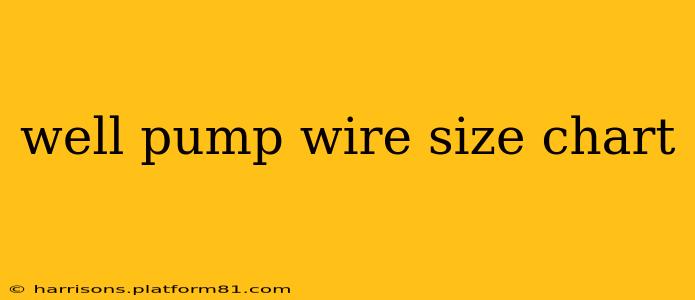Selecting the correct wire size for your well pump is crucial for ensuring efficient operation, preventing overheating, and maximizing the lifespan of your system. Using undersized wire can lead to voltage drop, reduced pump performance, and even potential fire hazards. This comprehensive guide will help you understand the factors influencing wire size selection and provide a practical approach to choosing the right gauge for your specific well pump application.
What Factors Determine Well Pump Wire Size?
Several critical factors influence the appropriate wire size for your well pump installation:
- Pump Horsepower (HP): Higher horsepower pumps require larger amperage and thus thicker gauge wire to handle the increased current.
- Voltage: The voltage of your system (110V, 220V, 240V, or 480V) directly impacts amperage draw and wire size requirements. Higher voltage systems generally require smaller gauge wire for the same horsepower.
- Well Depth: Deeper wells necessitate longer wire runs, increasing resistance and requiring larger gauge wire to compensate for voltage drop.
- Wire Length: The total length of the wire from the pump to the power source significantly impacts resistance. Longer runs demand thicker wire to minimize voltage loss.
- Ambient Temperature: High temperatures can affect wire's current-carrying capacity. Larger gauge wire is often recommended in hot environments.
How to Use a Well Pump Wire Size Chart (Understanding Amperage)
While a specific chart isn't universally applicable due to variations in conditions, understanding amperage is key. You typically find this information on your pump's nameplate or specifications. Once you know the amperage, you can consult the National Electrical Code (NEC) or similar electrical codes for your region. These codes provide tables that correlate amperage to appropriate wire gauge based on factors like wire material (copper or aluminum), installation type, and ambient temperature.
Choosing Copper vs. Aluminum Wire
Copper wire is generally preferred for well pump applications due to its higher conductivity, resulting in less voltage drop and less heat generation. However, aluminum wire is sometimes used due to its lower cost. If using aluminum, it's essential to ensure your connectors and terminals are specifically designed for aluminum wire to prevent corrosion and connection problems. Always check local codes for allowed wire types.
Frequently Asked Questions (FAQs)
Here are answers to common questions regarding well pump wire sizing:
What happens if I use the wrong wire size for my well pump?
Using undersized wire can lead to several problems, including:
- Overheating: Excessive current flow can overheat the wire, potentially causing a fire hazard.
- Voltage Drop: Significant voltage loss can reduce pump performance, causing inadequate water pressure or even pump failure.
- Reduced Pump Lifespan: Overheating and voltage drop contribute to premature pump wear and tear, shortening its lifespan.
Using oversized wire is generally safe (though more expensive), as it provides extra capacity and reduces the chance of overheating.
How can I calculate the correct wire size for my well pump?
Precise calculation requires considering all the factors mentioned above (horsepower, voltage, well depth, wire length, temperature). The most accurate method involves using the NEC tables and formulas, consulting an electrician or contacting the pump manufacturer for guidance.
What is the importance of using the correct wire size for my well pump?
Selecting the proper wire size is paramount for safety and efficiency. Improper sizing poses a fire risk, reduces pump performance, and shortens the pump's operational life. The potential repair costs significantly outweigh the initial expense of choosing the correctly sized wire.
Can I use an online well pump wire size calculator?
Several online calculators exist, but their accuracy depends on the input data. Always double-check the results with NEC tables and consider consulting a qualified electrician for critical installations.
Where can I find the specifications for my well pump?
The pump's specifications (including amperage and voltage) are usually found on a nameplate attached to the pump itself. This nameplate is usually found on the motor housing.
This information provides a starting point for understanding well pump wire size selection. However, for critical safety and performance considerations, consulting a qualified electrician is always recommended before undertaking any electrical work. They can accurately assess your specific needs and ensure the installation meets all relevant safety codes.
